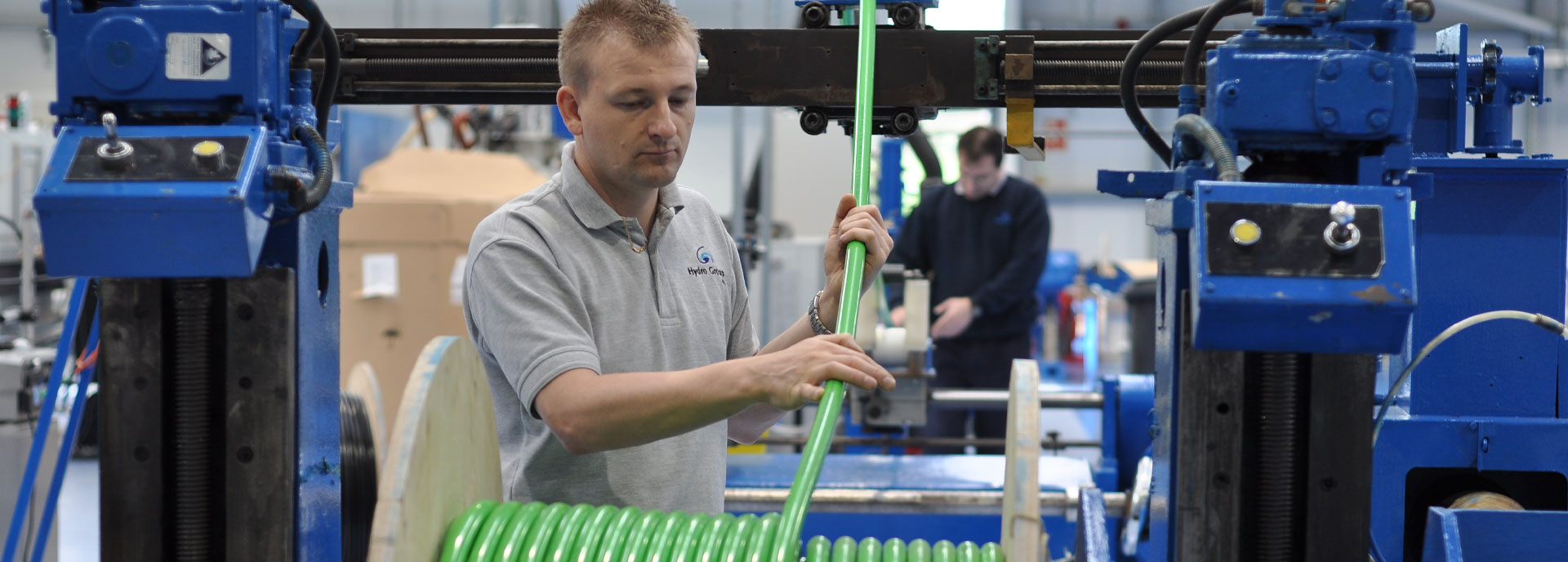Systems being deployed require reliable power and communications connections suited to meet these demands. The team at Hydro Group is being asked for increasingly complex composite and physically demanding cable designs. The days have gone when the company was simply asked to provide an underwater electrical connection.
Dynamic design: Most subsea cables designed and manufactured at the company’s Aberdeen, Scotland, facility incorporate numerous specialist elements such as fibre optics, twisted pairs, triples or quads, coaxial, and high-frequency and very high-frequency components.
As subsea equipment is becoming more complex with data management and collection systems transferring significantly higher volumes of information at faster rates, the transmission characteristics, low loss and shielding requirements need to be addressed in the design and composition of the cables.
To ensure the performance of the designs, increasing use of complex software modelling and analysis tools are employed. The company’s engineers routinely utilize packages such as Comsol multiphysics software to model designs and provide virtual realisation of the cable characteristics under a variety of simulated conditions. Transmission characteristics and performance also are simulated with the use of Optem software tools.
Stainless steel tubes rather than polybutylene terephthalate (PBT) tubes are incorporated regularly for all subsea cable designs that are for fibre optics. The benefits of using optical fibres contained within stainless steel tubes are primarily twofold:
• The attenuation (signal loss) seen in the fibre due to the compressive forces on the glass is minimized as the stainless steel tube protects from the crushing action of the water pressure on the fibre itself; and
• The addition of a hydrogen scavenging/absorbing gel is used within the tube to prevent the potential darkening of the optical fibres due to the natural ingression of small amounts of hydrogen, which are present in these extreme conditions.
Both of these advantages over PBT-tubed fibre optics are deemed crucial in the demanding conditions seen by subsea optical cables. Mechanical factors are extremely significant in the overall performance of subsea cable designs. Often these present a much higher risk in the reliability and durability of the design than all other constraints. The application of finite element analysis design and modelling tools such as Comsol and Orcaflex allow simulation and analysis of the design to ensure construction and incorporation of components that will meet the dynamic application requirements.
Under pressure: Understanding the static and dynamic forces that will be applied allows the incorporation of features and components in the designs (e.g., the use of Vectran braids and cords for tensile strength in lightweight and more flexible applications or the use of contra-helical steel wire armouring packages where significantly higher mechanical forces will be experienced).
The company recently invested in a new hydrostatic pressure vessel, which offers a broader range of testing with a more accurate output. The 2.5-m by 1.5-m (8-ft by 5-ft) vessel has the capacity to pressure-test large cable assemblies and equipment up to 1,450 psi, simulating depths of 1,000 m (3,280 ft) below sea level. This complements the suite of existing pressure vessels that allow simulation of depths to 7,000 m (22,966 ft) of seawater.
Advanced armour ocean environments vary significantly in different regions and therefore present different risks to consider, such as salinity, water temperatures and seabed conditions. As the industry explores deeper sea depths, this affects the design and material selection of cables, with challenges such as ultraviolet stability, marine growth, microbial attack and even the burrowing Teredo Navalis or “shipworm” to be addressed.
The combination of the above design factors and the fact that equipment demands are increasing rapidly is driving more customised solutions. In addition to the design approach employed and increased testing capabilities, Hydro Group has invested heavily in new machinery, significantly increasing and improving in-house cable manufacturing capabilities, to complement this rapidly evolving market.
At the start of 2015, the company installed and commissioned an advanced armouring line offering custom-designed single and multilayered steel armoured cables in galvanised improved steel and corrosion-resistant steels.
The new machinery allows the team to manufacture mechanically protected cables to improve and support subsea operations that can withstand higher stresses in subsea and defence operations as well as contra-helical armoured subsea control cables. These cables act to neutralise the tension and compression forces that occur in the wires each time the cable is bent or flexed. With a full appreciation of all electrical, optical, mechanical and environmental requirements imposed on the application of the cable, a robust and reliable cabling solution can be realised.
Hose bundles: The company developed a new hydraulic hose that offers lay-up and over-sheathing of hydraulic hoses for use in umbilical, topside and well intervention projects in the oil and gas industry and any deepwater applications or where there is a high differential pressure between the external and internal pressure of the hose.
The bundled hoses, which are available in ¼-in. to 2-in. sizes, integrate hydraulic components with electrical and fibre optic cables, resulting in a more compact and easier-to-handle assembly. This new capability allows the company to extrude up to 120-mm diameter over composite bundles or single hoses. Final produced lengths can be supplied from 50 m to 2,000 m (164 ft to 6,562 ft) depending on the size of hose, the number of components and the finished diameter of the umbilical.
The company has seen significant investment in equipment, facilities and training, enabling it to expand capability and offer technical skills and resources.



